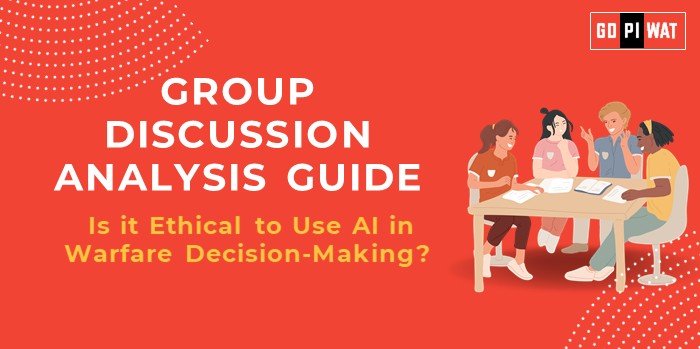📋 Group Discussion (GD) Analysis Guide
🤖 Topic: Is it Ethical to Use AI in Warfare Decision-Making?
🌐 Introduction
The integration of artificial intelligence (AI) into military operations has sparked transformative innovations and significant ethical debates. AI-enabled technologies, such as autonomous drones and decision-making systems, promise precision and operational efficiency but challenge fundamental principles of accountability and human judgment.
📊 Quick Facts & Key Statistics
- 🌍 Global Military AI Market: Valued at USD 9.31 billion in 2024, projected to grow at a CAGR of 13% from 2025 to 2030.
- ⚠️ Civilian Casualty Risks: Autonomous systems lack nuanced human judgment, risking harm to non-combatants in conflict zones.
- ✈️ AI-Powered Drones: Capable of autonomous target selection and engagement, raising accountability and ethical concerns.
- 📜 International Regulation: The U.S.-led Political Declaration on Responsible Military Use of AI, signed by 52 countries, aims to establish ethical guidelines but faces gaps with key nations like Russia absent.
🤝 Stakeholders and Their Roles
- 🏛️ Governments and Militaries: Drive AI advancements for strategic and operational advantages.
- 🏢 Tech Companies: Develop and deploy AI technologies, raising accountability concerns.
- ⚖️ Ethical and Legal Bodies: Advocate for frameworks ensuring responsible AI use.
- 👥 Civil Societies: Demand transparency, question the morality of autonomous warfare.
- 🌍 International Organizations: Work toward consensus on regulating military AI.
🏆 Achievements and Challenges
- Achievements:
- ✅ Operational Efficiency: AI reduces decision-making time, optimizing battlefield strategies.
- 🛡️ Reduced Risk to Soldiers: Autonomous systems can execute high-risk missions, minimizing human casualties.
- 🔍 Advanced Surveillance: AI-powered tools enhance situational awareness and threat detection.
- Challenges:
- ⚠️ Civilian Harm Risks: Misjudgments by AI systems could lead to unintended casualties.
- ⚖️ Accountability Gap: Determining responsibility for errors or misuse remains unresolved.
- 📜 Regulatory Hurdles: International consensus on ethical AI use in warfare remains elusive.
🌍 Global Comparisons
- 🇺🇸 United States: Leads AI innovation but faces public and global scrutiny over ethical concerns.
- 🇷🇺 Russia: Focuses on AI weaponization but resists regulatory agreements.
- 📜 Political Declaration: Signed by 52 nations to promote responsible AI usage but lacks universal endorsement.
🧠 Effective Discussion Approaches
- Opening Approaches:
- 📈 “With the military AI market valued at $9.31 billion, its transformative potential raises critical ethical concerns.”
- ⚖️ “Autonomous drones and AI decision-making systems are redefining warfare, but at what moral cost?”
- Counter-Argument Handling:
- Highlight safeguards alongside innovation to address ethical dilemmas.
- Present successful applications while acknowledging the need for regulation.
🔍 Strategic Analysis of Strengths and Weaknesses
- Strengths: Enhanced precision, reduced risk to soldiers, operational efficiency.
- Weaknesses: Algorithmic bias, accountability challenges, civilian casualty risks.
- Opportunities: Ethical AI frameworks, international regulation leadership.
- Threats: Lack of regulation, cyber vulnerabilities, misuse by non-state actors.
📄 Structured Arguments for Discussion
- ✅ Supporting Stance: “AI enhances strategic outcomes and minimizes soldier exposure to risks.”
- ❌ Opposing Stance: “AI systems cannot ethically or reliably make life-and-death decisions.”
- ⚖️ Balanced Perspective: “AI’s potential in warfare must be paired with strict ethical oversight and international agreements.”
📚 Connecting with B-School Applications
- 💼 Real-World Applications: Ethics in strategic decision-making, policy frameworks for responsible technology use.
- 📝 Sample Questions:
- “What ethical considerations should guide AI’s military applications?”
- “How can regulatory frameworks ensure the responsible use of AI in warfare?”
- 💡 Insights for Students: Explore parallels between military AI and corporate ethics, accountability, and risk management.


